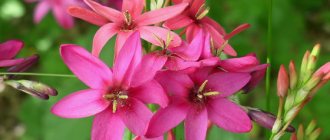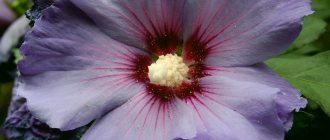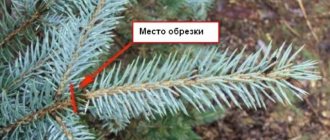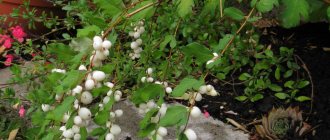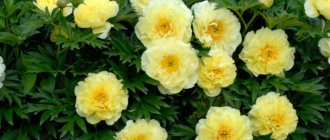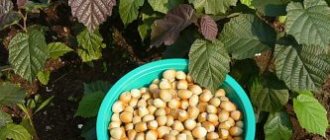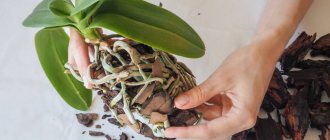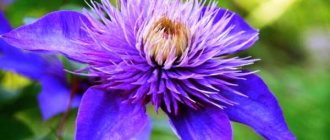Short description
This evergreen shrub grows up to 1 meter in height, sometimes reaching as much as 1.5. If not pruned, it grows strongly due to root sprouts, forming a hedge.
It is this property of mahonia that is often used by gardeners in landscape design. The bark of young branches initially has a gray-pink color, then, with age, it changes to dark gray, where the veins characteristic of the plant are visible.
Ripe fruits of the crop
Garden characteristics of Mahonia:
1 Mahonia grows slowly. Young branches first grow rapidly upward, then, gradually descending, spread straight to the ground.
1 The leaves resemble holly , which is why the culture received its name (holly). In winter, mahonia does not shed its leaves, but only changes its color from green to golden or red-brown. Until spring, the leathery, dense leaves with a glossy structure retain their crimson (red) color. Each massive element of the bush (20 cm in size) can have 5-6 small leaves.
3 It begins to bear fruit around the end of summer. If during flowering pollination was sufficient and timely, then the bush will be literally strewn with berries.
4 Mahonia erect inflorescences appear at the end of the branch at the end of spring , more precisely in the 3rd decade of May or 1st June. The flowers have a pleasant aroma and a variegated yellow color, which attracts pollinating insects to this plant. It may bloom a second time in autumn.
5 The fruits ripen closer to autumn. The color of ripe berries is blue-black with a bluish coating on top. The shape of the fruit is oval, the size is small (up to 1 cm). sweet in taste with noticeable sourness
.
Berries are not only tasty, but also beneficial for human health and can help treat certain diseases. Therefore, mahonia is often used in folk medicine.
Decorative culture
When planting mahonia in bright areas of the garden with fertile soil, the bush forms a dense, fairly dense, low grove. Which will certainly become an area for decorating the garden and a source of pride for the gardener who has grown such beauty on his site.
Mahonia in autumn
It is valued in landscape design for its decorative and beautiful appearance in any growing season:
- in spring and summer , during flowering, the shape of the inflorescences is large caps of yellow-lemon color against a background of dark green foliage with an original shape
- in autumn the green foliage turns golden, remaining on the branches even when all other shrubs have shed their leaves
- in winter , when snow covers the ground, mahonia branches acquire a crimson color. This sight cannot be described in words, and even a photo cannot fully convey all the beauty.
Until the end of spring, the bush again “repaints” its usual dark green color, and this happens from year to year.
Edibility
The taste of mahonia berries is reminiscent of barberry. Used fresh for dessert or as part of fruit salads. They are often combined with breakfast cereals such as muesli.
Delicious jam is prepared from mahonia berries
Another direction in using mahonia fruits in cooking is food coloring. It is used to color compotes and drinks a rich ruby color. Enthusiasts, growing the crop on their own plots, use the mahonia harvest to prepare delicious jams and marmalades.
Making mahonia berry jam is very simple:
- the fruits must be sorted, washed and blanched in boiling water for 6 minutes
- drain the water or drain the berries in a colander
- pour them into sugar syrup with a concentration of 60%
- bring everything to a boil on a low-burning gas heater
- transfer the contents into an enamel vessel, leave to stand for 12-14 hours
- put it back on the fire, bring it to readiness before removing, add a pinch of citric acid
According to those who prepared the jam, the taste of the product is simply amazing.
Medicinal properties
Mahonia belongs to the barberry family and, like all plants included in this group, is rich in berberine. This substance, considered a strong alkaloid, is often used as a medicinal plant.
The raw material for preparing medicine from mahonia is the root part of the plant.
The root is used in the preparation of an extract rich in a complex of valuable components, such as:
- tannins
- ascorbic acid
- organic amino acids
- various types of alkaloids and so on
The mixture tastes bitter, but it’s good:
- increases appetite
- slows down the aging process
- tones the body
- strengthens the walls of blood vessels
- stabilizes blood flow and circulation
- neutralizes the effects of free radicals
- endowed with antibacterial and anti-inflammatory effects
- has a beneficial effect on digestion
Mahonia has also proven itself well in dermatology. A tincture is made from it, which is used to treat skin rashes, herpes, psoriasis, and eczema. Drink to prevent and treat diseases. You cannot start treatment on your own; before doing so, you must consult with your doctor.
Types and varieties
There are about 50 unique specimens of a small ornamental shrub.
For example, mahonia aquifolium (lat. mahonia aquifolium) is a perennial evergreen plant of the Barberry family. The shrub has acclimatized to the warm, changeable weather of America. The gray bark contains sapwood inside, bright yellow wood with growth rings. The leaves with a spiky, jagged edge have a complex structure and stipules can form. During flowering they turn green to olive green. During the ripening period, the fruits turn dark green. In autumn and winter they acquire red-golden or bronze tones, and then change color to dark brown.
mahonia holly
The optimal height of a deciduous shrub is only 1.5 meters. The low-growing plant is decorated with multiple branched shoots. Yellow inflorescences, reminiscent of lush panicles, appear in the middle zone closer to the beginning of May. The flowers have 6 petals and the same number of stamens, arranged in two circles. Re-blooming is possible in October, during the hot “Indian summer”. After 3-4 years the tree begins to bear fruit. Blue-black or gray berries within 8 mm ripen in September. They have a sweet taste with a distinct sourness.
If you are breeding mahonia holly in the northern latitudes of Russia, you must take care in advance to cover the young seedlings for the winter.
The ideal material is dry foliage or spruce branches.
mahonia holly
In the southern regions of Japan and China, Japanese mahonia or lat. Mahonia japonica. It is a representative of the Buttercup order, the Barberry family. The evergreen tree was cultivated in Asia and gradually spread to Europe and the USA. Large dimensions up to 4 meters make it possible for single and group planting. Weakly branching shoots allow the plant to be used in decorative landscaping of personal plots.
The bark is covered with cracks, equipped with a cork layer, and has a gray tint. Young wood retains a bluish color. The apical buds with elongated dark green and oval scales reach 5 cm. Dense elastic leaves 30-45 cm long have the shape of an arc, bent downwards. During the ripening period, the fruits change color to red-purple.
Flowering in May-June is accompanied by the appearance of pale yellow petals, which are collected in buds with a diameter of 6 mm, and a pleasant aroma reminiscent of lily of the valley. With the arrival of September, blue oblong berries with a matte surface are visualized. The fruits are small, up to 8 mm in volume.
Japanese mahonia
Mahonia holly "Apollo" was bred by Dutch scientists in 1973. Received the name Mahonia aquifolium Apollo. The barberry shrub is a slow-growing evergreen garden crop. Forms an ideal ground cover due to its compact crown. Requires moisture maintenance, loves humus-rich soil and sunlight. During the dry season, watering can be done twice a week. For one bush, 10 liters of water is enough.
Despite the fact that the plant reaches only 0.6 meters, this disadvantage is compensated by intense flowering in May. You can enjoy the fragrant chocolate aroma of numerous yellow flowers for more than 25-30 days. The rich green leaves, 30 cm long, take on a bronze color at the end of August and turn red-brown in autumn. Sweet and sour berries ripen in early August. Dark blue fruits can be up to 1 cm in size. To protect the tree from frost, it should be covered during the first winters.
Mahonia holly "Apollo"
Mahonia media "Charity" or Mahonia media "Charity" is an upright shrub that reaches a height of 1.5 meters. An adult plant has an oval crown with a diameter of 60 cm and numerous shoots. The hard oval leaves are equipped with sharp teeth along the edges. Shiny and green in the summer, they turn burgundy by autumn. The yellow flowers, which appear in May, are collected in apical spikes. Already at the end of summer the tree bears fruit with blue-black berries. Like all specimens of mahonia, they acquire a bluish tint. The advantage of planting "Charity" is its unpretentiousness. Prefers partial shade and does not require additional soil fertilization. To be on the safe side, with the onset of cold weather you can insulate the bush.
Mahonia media 'Charity'. Oregon grape
Mahonia repens is known from Canada to New Mexico, California and the northern United States. But the creeping shrub 50 cm tall has not gained wide popularity. Blue-green matte leaves of a round shape have teeth along the edge, united in 3-7 pieces. Flower clusters appear in May, and fruits in September. Black berries with a distinct fluff taste sweetish and sour. Thanks to root growth, the plant acquired the status of a bush. The following types of creeping mahonia are used for decorative purposes:
- round-leaved. The shoots consist of 5 separate leaves;
- large-fruited. The size is 1.5 times larger than traditional berries. They are classified as poisonous and dangerous.
Frosts do not affect the plant. Easy to care for. Transplantation does not depend on the age of the bush. You should avoid replacing the soil only in late autumn. If you plant an evergreen tree in dense groups, you must maintain a distance of 1 meter. Particular attention should be paid to the soil. We must not forget the proportions of humus, turf soil and sand, maintain a ratio of 2:1:1. It is necessary to feed in early spring and before flowering. The soil must be constantly loosened, since the low-growing species does not like compaction. In clayey areas, it is better to provide drainage, the layer of which should be about 20-25 cm.
For planting, it is better to choose a well-lit place or partial shade. Otherwise, the growth rate and overall appearance of the landscape will slow down.
In order to pollinate mahonia, it is recommended to place several bushes nearby. This will help speed up the cross-transfer of pollen in the plant and increase the volume of future fruits. If there is no need for berries, this rule can be circumvented. The stimulator for intensive growth and lush forms is sunlight and humus soil. When designing and creating a natural design in a city or an elite suburban area, the shoots are shortened and the crown is trimmed.
Features and nuances of care
The shrub is grown in open ground conditions. One of the key features and conditions is timely watering. An adult plant should be watered at least 2-3 times a month (in severe drought conditions up to 4 times). Under each bush you need to pour at least 8, preferably 10 liters of settled water.
Young seedlings are ready for transplanting
Young shrubs need to be watered less (in terms of the amount of water), but more often (in terms of the number of times).
Mahonia is not demanding in terms of winter preparation. It tolerates even very severe frosts well. Some shoots may be slightly damaged by winter, so in the spring the plant should be carefully inspected and, if necessary, damaged branches removed.
Only young bushes, younger than 3-4 years, need to be prepared for wintering. They do not have time to adapt to low temperatures during this time and are considered very vulnerable. They will need to be covered for the winter, for example, with dry grass or branches. After they reach 3-4 years of age, this manipulation does not need to be done.
Plants do not require pruning if grown as a hedge. You just need to shape its shape. If mahonia is grown as an independent shrub, pruning should be done after flowering.
It is not recommended to prune the bush often - the crop grows very slowly, this must be taken into account.
Diseases and pests
Holly magnolia is resistant to various diseases and pest attacks. Infection of a plant can occur due to the presence of garden crops with parasitic microorganisms nearby. The most common diseases of shrubs include:
- phyllosticosis;
- stagonosporosis;
- powdery mildew;
- rust.
The course of these diseases is accompanied by damage to the leaves. For treatment it is necessary to use fungicides, such as:
- copper oxychloride;
- Bordeaux mixture;
- Phthalan;
- Tsineb.
When using them, you must adhere to the recommendations specified in the instructions from the manufacturer.
Preparing a site for planting young bushes
The place for the growth and development of mahonia plays a significant role. This crop does not tolerate areas that are too sunny; direct sunlight can easily burn the plant, which can easily be seen on the foliage. The crop grows best in shaded areas.
Mahonia feels more comfortable in the shade
Despite the fact that mahonias love shade, they do well in intense heat in the summer. Plants are much more afraid of a strong draft. It is recommended to plant seedlings near buildings or gardens. This way they will be at least partially protected from the sun.
The plant is not too picky about the type of soil, but it doesn’t really like to grow in sandstone or clay soils. Prefers loose soil with a sufficient amount of nutrients.
Planting and growing mahonia in open ground
As a rule, caring for mahonia is not accompanied by difficulties. It has a powerful root system that provides the above-ground part with micronutrients and moisture.
What time to plant
Typically, mahonia holly is planted in open ground in the spring. This allows the plant to take root well and begin to grow before frost sets in. But some gardeners plant this shrub in summer and autumn.
Mahonia cannot be planted in open ground in winter.
In the southern regions, a similar procedure is recommended to be carried out in the fall, preferably before mid-November, since shrubs planted in the spring often need moisture in dry conditions. In some cases, mahonia purchased in containers is planted in the summer, then a shaded area is selected for it.
Landing Features
It is best to plant mahonia in an area with good lighting, which is reliably protected from drafts and wind. It is permissible to grow in conditions of slight shading, but then there will not be a good fruit harvest. When choosing a place for planting, you should take into account that exposure to direct sunlight will negatively affect the condition of the plant’s leaf blades. The optimal place for planting will be an area located in partial shade from tall trees.
The place and hole for the bush are prepared 2 weeks before planting. The diameter and depth of the planting hole should be 0.5 meters. If the selected area has clay soil, then the depth must be increased, this will allow a drainage layer to be made at the bottom of the hole.
Stagnation of water will be detrimental to mahonia, so the area must not only be properly drained, but also organize the drainage of water that accumulates as a result of melting snow or rain.
After planting the plant, the hole is sprinkled with a mixture consisting of sand, turf soil and humus. When forming a hedge or border from mahonia, it is recommended to maintain an interval of 100 cm between plants. When planting loosely, the distance between bushes should not be less than 2 meters.
Before planting, you need to carefully examine the root system of each seedling. Affected and dried fragments must be removed, and too long fragments must be shortened. Treat the cut areas with crushed charcoal.
Shrub seedlings with bare roots are dipped in a growth-stimulating composition before planting.
Mahonia should be planted so that its root collar is slightly above the soil surface. At the end of the procedure, the soil near the trunk of the plant must be compacted and watered abundantly. After water is absorbed into the ground, the area around the tree trunk is covered with mulch.
When and how to transplant seedlings
The best time to transplant is early spring
You need to start replanting early. During this period, the plant has not yet entered the stage of sap flow and no serious vegetative processes are taking place in it yet. But you should not be afraid of transplanting when the foliage on the seedlings has already blossomed and is still young. During this growing season, Mahonia will react calmly to changing its place of growth.
It is not recommended to replant in autumn, especially late. The plant will endure this painfully and may even die.
How to plant crops correctly:
- Before transplanting, you need to dig holes. Their size should be three times larger than the root system of a young bush. The depth of the pit is approximately 50 cm.
- About 1 bucket of humus mixed with soil and sand (in equal parts) is added to the hole, the bottom is covered with some of it , the remaining amount will be needed to fill the hole. The plant is inserted horizontally into the hole. If there is a lump of earth on the root, try not to destroy it. The open root system is melted well so that the shoots are not wrapped.
- The bush is sprinkled with earth and lightly compacted.
- After planting, water the seedlings abundantly and regularly. The soil should not be allowed to dry out; soiled crusts are undesirable. After watering, it is good to fill the circle around the bush (near the trunk) with humus or any type of mulch.
The plant will take root quickly if you do not skip watering.
The plant must be planted so that the level of the root collar is the same both before and after transplantation, or 3 cm lower. So, after the soil shrinks, the root shoots will not be exposed, and the plant itself will not get sick and weaken from this.
Features of the Mahonia shrub
Mahonia is an evergreen shrub, reaching a height of about 100 centimeters. It has abundant root growth. On old stems the bark is brownish-gray, and on young stems it is grayish-pink. The odd-pinnate compound leaf blades have light red petioles and consist of 5–9 sharp-toothed, notched leaves, which reach 15–25 millimeters in width and 3–9 centimeters in length. These leaves are dark green, leathery, their front surface is shiny and the back surface is matte. Multi-flowered axillary racemose or paniculate inflorescences consist of bright flowers of a pale yellow color (sometimes found with a lemon tint), the diameter of which can reach 0.8 cm. The fruits are oblong-elliptical berries, painted black and blue, with a a thick coating of bluish-colored plaque, as well as a cannon. These berries reach 1 cm in length and 0.8 cm in width; they have a rather pleasant sweet and sour taste and are used in confectionery production, and they are also used to color wines. Flowering occurs in April and May, while the berries ripen in September or August.
In landscape design, this plant is used to create borders, low hedges, group plantings, it is also planted solo or used for lining tall shrubs. In winter, the shiny leaf blades change their color to green with a beautiful red tint. Also, this shrub looks very impressive during the ripening of purple-blue berries covered with a waxy coating.
Shrubs for the garden. Mahonia holly. Website "Garden World"
Caring for seedlings and adult plants
The principle of caring for mahonias is practically no different from any other garden crops. only urgently need watering, timely weeding, and loosening the soil. It is possible and very desirable to sometimes spray the crown in the evening. Pruning of side shoots and branches is carried out only after the plant reaches 10 years of life.
Magnolia does not require anything “special” in terms of care.
If it is noticed that the plant begins to get sick, you need to immediately take measures to eliminate this problem; you can treat mahonias for preventive purposes, but not too often.
Watering
Mahonia of any variety is a moisture-loving plant. Therefore, watering should be regular and abundant. Irrigation should begin from the moment the young seedling is planted in open ground conditions. When carrying out root watering, it is advisable to sprinkle the crown of the bush with water.
The procedure must be performed twice a day - in the mornings and evenings. There is no need to water mahonias in the daytime sun. The amount of water per adult bush is at least 1 bucket.
Mahonia loves water
You can reduce or stop watering altogether if it has been rainy outside for several days. It is necessary to loosen the soil only the next day after irrigation.
Top dressing
Fertilizers for feeding
It is necessary to feed the bush, but not often. Just two feedings are enough to provide the crop with enough nutrients and nutrients for the entire season.
- The first fertilizing is done in early spring. Fertilize the bushes with nitrogen-containing compounds. Nitrogen promotes the growth of green mass and the normal development of shoots
- the second feeding should be carried out at the time of flowering. Complex fertilizers for garden flowering crops are appropriate here.
There is no need to feed the plant anymore.
Mulching
Mulched bushes
Mahonia needs to be mulched and here’s why:
- mulch from dry leaves for the winter is to save the bush from severe frosts. And, rotting, this organic matter will become an excellent nutrient substrate for mahonias
- Mulched bushes will always have good microflora and the presence of worms. After all, they are the ones who improve the physical and mechanical qualities of the soil, making beneficial compounds more accessible to the root system, and therefore to the entire plant
- Mulching prevents the soil from drying out too much and prevents crusts from forming on the top layer of soil.
As you can see, the benefits of mulching are obvious and undeniable. Therefore, there is no need to be lazy and mulch young zeal.
Trimming
Mahonia does not require radical pruning. In early spring, you can do a little sanitary pruning by removing slightly damaged shoots, frostbitten after the winter, weakened by illness or other factors.
Sanitary pruning of bushes
To make the plant bloom more luxuriantly, pruning can be done in the fall or after the bush stops blooming. Remembering that the planting of flower stalks is carried out not on new shoots, but on last year’s ones. What does this mean? Their length should be reduced by no more than 1/3 of the total length of the branch.
Preparing before winter
Mahonia in winter
If mahonia grows in mid-latitudes, it is not at all necessary to cover the bushes before wintering. Only if a very serious cold snap is expected will the bushes need to be covered with spruce branches.
Bushes that are too young need to be thoroughly covered.
Plant propagation methods
You can get additional plants for your plot by cuttings, dividing rhizomes or planting seeds.
Cuttings
This is the most popular method of propagating Mahonia holly. If the procedure is carried out correctly, you can grow a beautiful and healthy plant.
When propagating mahonia holly by cuttings, it is necessary to take into account the following expert advice:
- Only healthy green shoots are chosen for cuttings;
- From below, planting material is cut obliquely, from above - at right angles;
- so that the separated branches take root faster, they are treated with stimulating drugs;
- large leaves are removed up to half;
- the cuttings are placed in an earthen mixture, deepened to the first bud;
- plants are watered and covered with a jar or placed in a greenhouse to accelerate root growth;
- It is important to carry out preventive watering or spraying with fungicides.
Division of rhizomes
Another popular way of propagating mahonia holly is through layering. For this purpose, in the spring the shoots are tilted to the ground, secured with wire, and covered with earthen mixture so that the top is above it. This way the cuttings will take root faster. If necessary, additionally cover the ground with polyethylene and periodically irrigate it. The shoots are left in this state until autumn. When the roots are well formed, the shoot is cut off from the mother specimen and planted as an independent plant. If the roots turn out to be small and undeveloped, I leave the shoots to take root until spring.
Seed method
This is a more complex type of reproduction. Growing mahonia holly from seeds is carried out both in autumn and in spring. The seeds are first kept in the refrigerator for at least three months. For autumn sowing, this procedure can be omitted, but they can be sown well in advance of frost. The seeds are buried only 1.5-2 cm.
Another option for obtaining a new shrub is to cut off several shoots in winter and place them in a jar of water. Keep them in a bright, warm place. After a couple of months, the branches take root. Instances that remain the same should be buried on the site in the spring.
Landscape use
Successful use of mahonia in the landscape of a personal plot
When landscaping a plot with mahonia, one must not forget that this culture is shade-loving . Otherwise, its leaves may fade in the sun. The best places for planting are areas located under taller trees or shrubs.
Holly-leaved mahonia looks very colorful when planted in small groups or in the form of a hedge with a neatly trimmed (but not short) crown. This crop can be used to fill the lower rows against the backdrop of taller garden crops. It is capable of producing dense basal shoots, forming an evergreen living carpet under shrubs or fruit trees in the garden.
The best garden crops for landscape design
Mahonia's companion plants are:
- garden rose
- everblooming bulbous
- rhododendron
- azalea
- Erika
- magnolia
- camellia
Mahonia is resistant to polluted external environments . Therefore, it is often planted in suburban gardens near highways, industrial enterprises, and so on. So that she could at least a little clean the air in the area.
VIDEO: Spring pruning of bushes
Application in landscape design
Connoisseurs of low-growing evergreen shrubs are familiar with Holly Mahonia. Unusual serrated leaves, elegant yellow inflorescences and dark blue berries create a unique harmony and cozy atmosphere in the garden of a country house or on a personal plot.
We offer options for how mahonia is used in landscape design:
- looks attractive against the background of stone compositions;
- looks impressive, both alone and in combination with chrysanthemums, heucheras, dicentras, conifers;
- plays the role of a hedge and is located along the perimeter of the lawn;
- decorates the shady part along with ferns, hostas, primroses;
- in the sun it peacefully coexists with azaleas, camellias, and rhododendrons.
Professional designers know a lot about elegant compositions and original landscapes. Using mahonia, it is very easy to make a small fairy-tale hill or mountainside with a cascading waterfall.
Types of mahonia holly found in nature
Gooseberry Ural emerald - features and characteristics of the bush
Some varieties of mahonia have their own characteristics of cultivation and care. Below are some of the most famous species in gardening.
Creeping Mahonia (Mahonia repens)
The shrub varies in height from 20 to 50 cm. The leaves are large green. Blooms from late spring to early autumn. The fruits ripen towards the end of the summer season. The mahonia flower has a lemon color. The plant survives even with sudden temperature changes.
Creeping
Japanese Mahonia (Mahonia japonica)
Widely distributed in Japan and other tropical regions. The aroma is reminiscent of lily of the valley flowers. The shrub grows up to 150 cm. The inflorescences are directed in different directions. The flowers have a bright yellow tint.
Japanese
Mahonia Winter sun
The plant reaches 200 cm in height. Blooms in winter. In appearance it resembles Japanese.
Winter sun
Mahonia Fremontii
The shrub grows up to 300 cm. The young plant has gray-blue leaves. The berries are red.
Fremonti
Mahonia eurybracteata Soft Caress
The plant comes from China. The leaves are narrow. Flowering occurs in summer. The bush is grown in special containers and in greenhouses.
Software
Mahonia Neubertii
The height of the plant does not exceed 110 cm. The leaves are ovoid in shape.
Newbert
Additional Information! The listed species are artificially bred hybrids of barberry with other varieties of mahonia.
Conditions for growing crops
The evergreen shrub became known to European gardeners back in the 19th century, and relatively recently became one of the most common plants in Russian gardens. In nature, this culture grows in North America and is often found on the edges of forests and open areas. The shrub loves light, but at midday it needs light shade from tall plants growing nearby. In such conditions, mahonia holly blooms more luxuriantly and produces tasty fruits.
The climatic conditions of Russia are suitable for growing most varieties of southern beauty. It can withstand relatively mild Kuban winters, grows well in the Moscow region and the middle zone, as well as in the Leningrad region. In the conditions of central Russia, it does not need shelter for the winter. If you plant a plant in Siberia and the Middle Urals, the likelihood of freezing increases, especially if you do not take care to protect it from piercing winds.
This culture reacts extremely negatively to drafts, especially if north winds prevail. To avoid death, planting and care must include protection from drafts. To do this, it is planted so that buildings or tall trees are located on the north side.
For planting to be successful and the plant to develop without problems, choose loose and fertile soil; it should contain a lot of humus. Therefore, before planting, it is necessary to add a lot of humus and leaf soil - at least 7-10 kg per 1 m². You should not add sand to the soil, even if it was initially dense, but it is better to use vermiculite or create a drainage layer of fine crushed stone at a depth of 40-50 cm, as it will prevent stagnation of water at the roots.
Mahonia holly berries - pictured
The crop is not demanding of moisture, and if the groundwater in the area lies close to the surface, the shrub should be planted in an elevated place or a drainage layer at least 30 cm thick should be created. Problems with cultivation may begin if the roots get wet. If the soil is waterlogged, the crop can die quite quickly.
Any trees and shrubs are suitable as neighbors for the plant, the planting and care of which coincide with it in its main points.
What types of mahonias are there?
Gooseberry Kolobok - secrets of growing shrubs
Mahonia is crossed with plants from the barberry genus. Among the popular decorative forms are the following:
- Nutifolia (f. juglandifolia). Looks like mahonia holly. The difference is in the foliage. The plant has 7 small leaves on each branch. The leaves are dense with red petioles.
- Graceful (f. gracilis). Differs from the typical species in having longer leaves.
- Golden (f. aurea). The foliage of this mahonia has a golden color.
- Variegated (f. variegata). The leaves contain a heterogeneous color consisting of green and gold spots.
Additional Information! Caring for the above decorative species is no different from caring for ordinary mahonia.
Varieties most popular among gardeners
Rose Pomponella - characteristics of the varietal shrub
The varieties presented below are winter-hardy and unpretentious in care, which attracts the attention of gardeners.
- Mahonia Apollo. The bush grows from 50 to 100 cm. The leaves are 25 cm long, have a sharp-toothed edge and consist of 7 leaf plates. In summer they are green, and in autumn they turn brown. The flowers are lemon-colored. Dark blue berries contain a waxy coating on the skin.
- Mahonia atropurpurea (Autropurpurea). The height of the bush reaches 65 cm. The leaves are dark green. They do not exceed 30 cm in length. The flowers are bright yellow.
- Mahonia Smaragd. A distinctive feature is shiny emerald-colored leaves with a clear pattern of veins.
Proper wintering in the Moscow region and other regions
Mahonia tolerates low temperatures well. Only young bushes that were planted one or two years ago need to be prepared for wintering. This happens as follows:
- In October, the root system is earthed up. The neck and trunk circle are covered with earth (the higher it is, the better).
- Mulch with straw, sawdust, hay. The base of the bush is covered with spruce branches. This will help prevent the rhizome from freezing.
- Mahonia branches are protected by covering them with snow. This is not necessary, but it helps a lot in cold weather.
Mulch and spruce branches are removed as soon as the snow melts. This is necessary to warm the earth. The soil around the plant is leveled.

